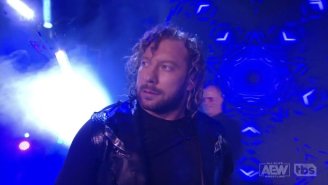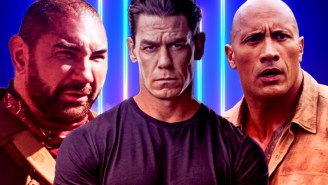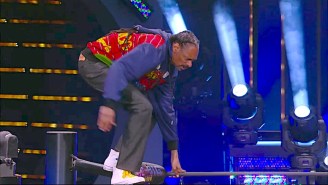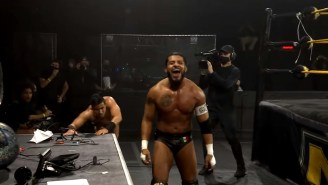November 30th marked 15 years since the passing of professional wrestler Tim Woods. Ric Flair once called him “the man who saved wrestling,” and for good reason. You may have heard the tale before, but you might be very unfamiliar with Woods’ role in one of the most infamous and history-altering incidents in professional wrestling.
On October 4th, 1975, five passengers and one pilot boarded a twin-engine Cessna 310 in Charlotte bound for Wilmington, North Carolina. It was scheduled to be a 45-minute flight. Upon its descent into Wilmington Airport, the plane ran out of gas, stalled out and clipped the top of the treeline and a utility pole before crashing to the ground.
The pilot was a 28-year-old Vietnam veteran named Joseph Michael Farkas, who had difficulty during liftoff in Charlotte due to the unplanned total weight of the passengers — several of whom were professional wrestlers. He made the mistake of not adequately distributing the weight of the passengers in the plane and, once airborne, elected to dump fuel in an effort to lessen the burden on the tiny plane.
Farkas radioed the Wilmington control tower around 6:25pm to report that one of his engines had failed. The plane crashed between the railroad tracks and a prison farm a half mile away from the airport. Several of the victims were thrown from the airplane, and one was pinned between two seats. Farkas underwent surgery for head injuries late into the night, slipped into a coma, and died the following year.
The passengers on that flight were National Wrestling Alliance executive David Crockett, professional wrestler Robert Bruggers, professional wrestler Johnny Valentine, a 24-year-old wrestler by the name of Ric Flair, and promoter George Burrell Woodin. Most of them sustained severe injuries. Woodin suffered a broken back. The young Flair had his back broken in three places, and was later told by doctors he may never wrestle again. Bruggers had a steel rod inserted into his spine and elected to retire from the business. The veteran Johnny Valentine, who switched seats mid-flight with Flair, was paralyzed for life.
Flair, of course, followed a vigourous physical therapy regimen and made an almost miraculous comeback to the ring eight months later to face Wahoo McDaniel. Goodwin beat Flair back to the ring by seven months and two weeks.
You see, George Burrell Woodin wasn’t his “real” name, except for the fact that it was his real name. Some fans knew him as Tim Woods, but most of the world knew him as the masked superstar Mr. Wrestling … and that was a very real problem.
Mr. Wrestling was a “babyface” — a good guy. Ric Flair was a bad guy. In 1975, professional wrestlers and promoters went above and beyond to maintain the suspension of disbelief that these feuds were legitimate. The storylines that were presented in the ring and on the screen were treated as real-life disagreements between professional athletes competing for championships, money and pride. The only thing that kept these combatants from killing each other were the officials who enforced rules and regulations … as far as the fans knew. At the time, Mr. Wrestling was in a feud with both Johnny Valentine and Ric Flair.
While lying in a hospital bed, and with no way of knowing if his compatriots were alive or dead, Mr. Wrestling provided his true name (George Burrell Goodwin), and then lied about his job to preserve the illusion of wrestling. He knew that if word got out that a good guy, the owner of the company’s brother and three bad guys were all on the same plane, it could ruin that illusion forever.
Whispers began to circulate that Mr. Wrestling was indeed on that fateful flight. Unwilling to expose the secrets of the business, Mr. Wrestling donned his mask and had a match under extreme duress and enormous physical pain to “prove” that he could not have been involved in the accident.
That incredibly courageous act made it possible for the professional wrestling business to continue in its current form. Mr. Wrestling kept kayfabe sacred and singlehandedly saved the livelihoods of every single other wrestler in the world — at least as far as his contemporaries were concerned.
Walk with me down a video memory lane as I demonstrate just what kind of man Mr. Wrestling was, and the type of passion he had for a business where he would make so great a sacrifice.
Check out this rare 8mm footage of a rare black-mask-clad Mr. Wrestling against Pak Song in the early ’70s. Who was Pak Song? Oh, nobody; just a guy with a Viet Cong gimmick who feuded with Dusty Rhodes in 1974 and made him the biggest babyface in the world. No big whoop. That’s Mr. Wrestling stomping him to death, pre-crash.
https://www.youtube.com/watch?v=PJqOljho9vQ
You have to realize what kind of legit badass Tim Woods was that made it possible for him to step into a ring a mere fortnight after a plane crash that left one man in a coma and another man paralyzed. As an amatuer wrestler at Michigan State, Georgie Boy won two Big Ten titles and came in second in the National NCAA tournament in 1958 and 1959.
Jim Cornette tells a fun story about Mr. Wrestling doing the old carny thing where any local could get in the ring to challenge the wrestler for money, and the guy bit his finger off. What, you thought that scene from Spider-Man with Randy Savage as Bonesaw was made up? Needless to say, after successfully preventing Mr. Wrestling from strangling the guy with what was left of his bare hands, they stopped doing that gimmick in Columbus, Georgia from then on.
Here’s Mr. Wrestling going toe to toe with none other than Dory Funk Jr. in a super stiff match in Japan in 1979, where Dory is working his arm and back. You know; four years after he broke his neck in a plane crash. Ridiculous. The handshake of respect at the end is legit.
Here’s Mr. Wrestling returning to Georgia Championship Wrestling, looking ultra-spry a little over five years after a plane crash that left no one unscathed, and backing up Mr. Wrestling II in an angle against The Assassins. Because professional wrestling is awesome.
Burly, “let me tell you something” middle-aged white dudes in masks is something that must come back immediately. God, what I wouldn’t give for Zayn/Owens to get fired at Clash of Champions only for the following Tuesday to have “El Local” and “Le Cavalier de Minuit” show up and wreck shop. LCdM cuts an entire “working man” promo in French while his mute buddy just looks on silently until he hears his name and starts nodding his head vigorously and pointing to himself. Tell Vince he’s getting four wrestlers for the price of two, and book a Mask Vs. Hair match with Shane and Daniel Bryan already.
That aside was vital to my thesis here: I get to fantasy book that little piece of fairytale magic above because Tim Woods believed that professional wrestling was a story worth telling. Think of how many lives would be different if the business had been exposed back in 1975. Would professional wrestling as we know it even exist? Would there even be a Kevin Owens or Sami Zayn? Would there have been a Ric Flair? Would there have even been this website to hire me to write about these things?
Mr. Wrestling finally hung up his boots in 1983, a full eight years after that terrifying night in North Carolina. He opened up a heating and air conditioning store, collected motorcycles and played his beloved saxophone, because of course he did. You can’t make guys like Mr. Wrestling up.
George Burrell Woodin passed away from a heart attack on November 30th, 2002 in Charlotte, North Carolina at the age of 68. Before he passed, he had scheduled an interview with WWE Confidential to talk about the crash.
I will bet you all the money in the world he would have denied ever being there.






